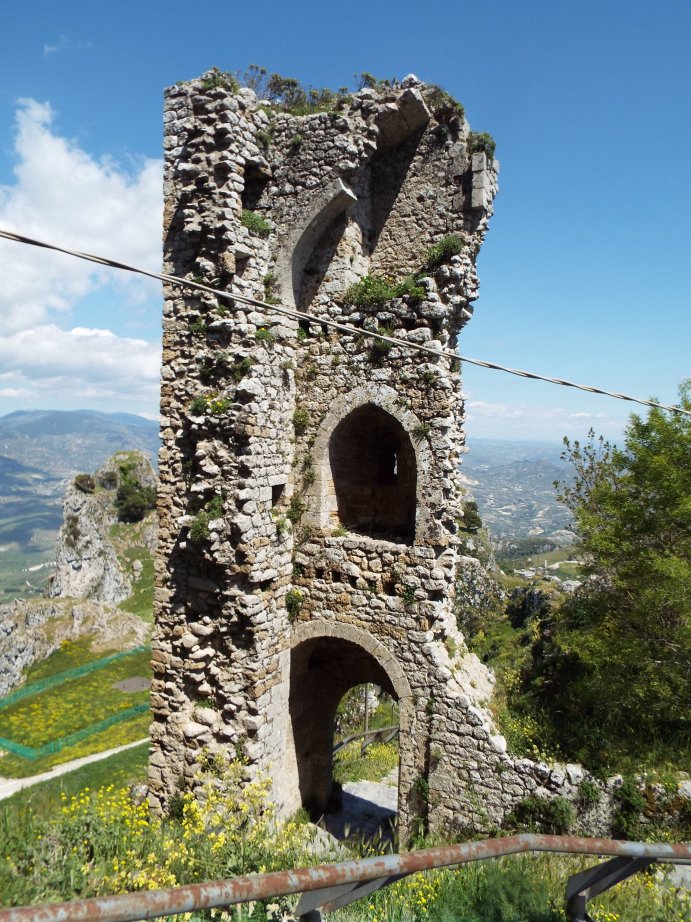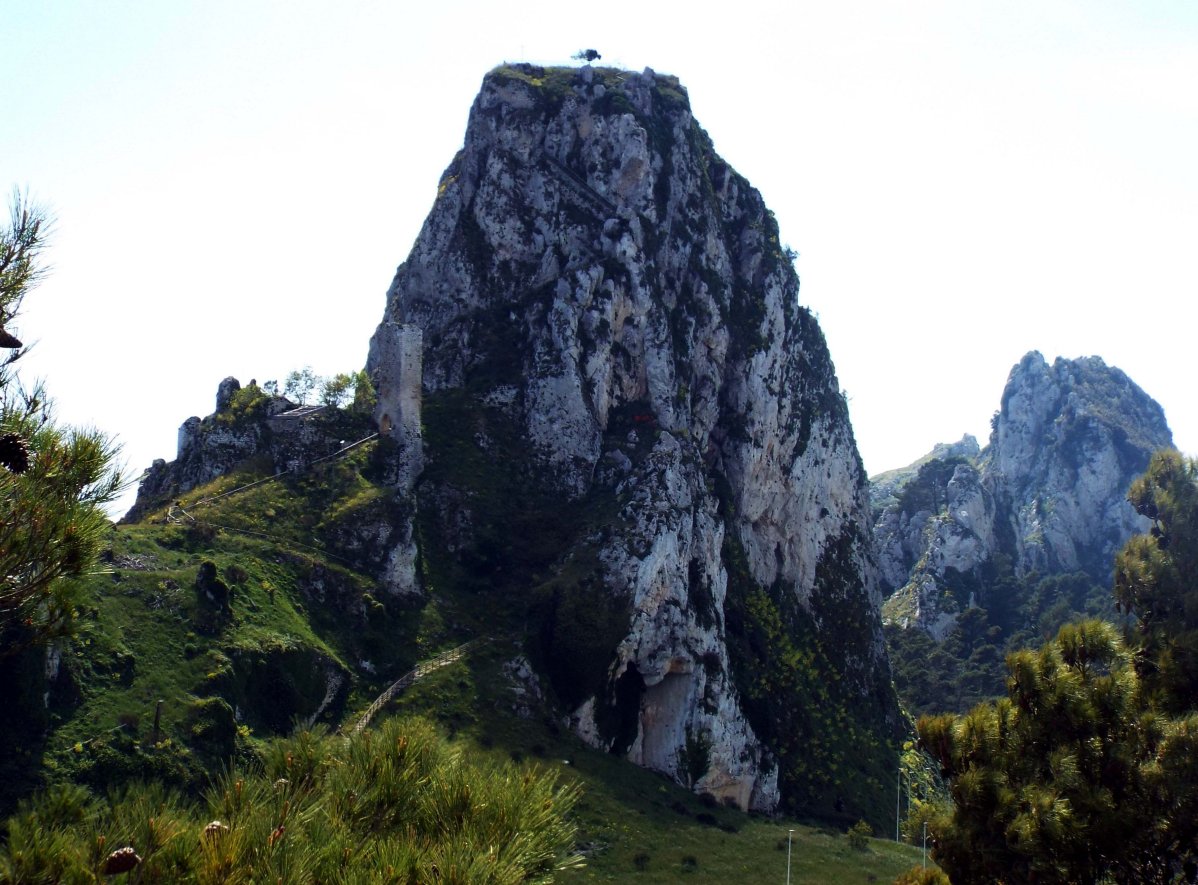Caltabellota
The fortress was probably a Byzantine foundation, being
captured from them by the Muslims in 839-40. Subsequently the
invading Normans under Count Roger
(1060-1101) attacked the Arab garrison here in 1090 and after it fell
refortified the site. This rebuilding is said to have included
the foundation of the cathedral to replace the earlier church of San
Salvatore. The cathedral was damaged in an earthquake in 1968.
The castle, being in an isolated postion did not figure a great
deal in Norman history.
After the death of King Tancred in 1194, the Swabian Emperor Henry VI (d.1197) invaded Sicily virtually without opposition, the defences of Queen Sibilla and her young son, William III,
surrendering en masse as he advanced. Most of her children
were sent to the well provisioned tower of Caltabellotta castle for safety, while she attempted to hold Palermo
against the invaders. However, the city surrendered and she fled
after her children, King William III and his 3 sisters. At this
point, with only Caltabellotta, Vicari, Caltavuturo and Calatamauro holding out for King William, the emperor offered her generous terms, that her son would become
prince of Taranto and that she would be forgiven. So, on 20
November 1194, the Emperor Henry VI entered Palermo and was crowned
king of Sicily in the cathedral on Christmas day, in the presence of the surrendered Queen Sibilla and the ex.King William III,
who had reigned for just 10 short months. Despite this, just 4
days later she and her entourage were accused of a conspiracy to kill
the emperor and packed off to Germany. None were to return.
The fortress was retained by the Crown during the 70 years of Swabian
rule and on 3 May 1272 was recorded as holding an Angevin garrison of 1 knight
and 6 sergeants. This was at a time when most of the royal
castles in the western half of Sicily were held only by squires.
Of the 18 other royal castles in the west only Caltanissetta, Favignana, Licata and Vicari were
held by knights. It has been suggested that in November 1270 a
banquet was held at the castle by Count Guido di Dampierre of Fiandra
after he had landed in Trapani on his return from the Tunisian Crusade
which had witnessed the death of King Louis IX of France.
With the defeat of the Angevins in 1282 various royal castles were handed out
to supporters of the Aragonese crown. Consequently by 1296,
Caltabellotta was held from Frederick III (d.1337)
by the Abbate Barresi, but it was then given by the king on his
coronation to Berenguer Vilaregut. This resulted in the Barresi
rebellion at Pietraperzia. Later in 1302, the castle was
the setting for the formal end to the war of the Sicilian Vespers which
had begun in 1282 in Palermo. After
the defeat of King Philip III of France at Courtnai in Flanders on 11
July 1302, the French king called the Angevin claimant to Sicily, King
Charles of Naples (d.1309), back to France to help salvage what he
could from the defeat. Consequently Charles, who at the time was
besieging Sciacca, offered Frederick terms he could not refuse. Frederick III
(d.1337) promised to marry Charles' daughter Eleanora and be king for
his lifetime only, the crown then reverting to Charles's family.
The treaty was signed at Caltabellotta, just 10 miles from Sciacca on 31 August 1302, finally ending the war begun in Palermo in March 1282 with the Sicilian Vespers and leaving Caltabellotta in the hands of King Frederick III (d.1337).
In 1325 the Angevins seized Caltabellotta during
their invasion of Sicily, although by the end of the decade it was back
under Aragonese control in the form of Abbate Barresi although the territory (terragium) was said to be under Gonsalvo Olea before 1330.
Some time later the castle passed to Raymond Peralta (d.1348), who was made count of Caltabellotta by King Peter II
(1337-49). Later it passed to his second great grandson Nicholas
(d.1391), whose heir, Margaret, married Artale Luna in 1400. The
castle then remained in the Luna family until 1673 when Ferdinand
Aragon Moncada became castellan. It was probably abandoned soon
after this. Perhaps the earthquake of 1693 helped it on its way.
Description
The castle stands on and around a boss of rock, commonly called the
Pizzo. This reaches a height of 3,113' and gives views to the
castles of Giuliana to the north and Luna of Sciacca
to the southwest, as well as the Saracen fortress of Burgio to the northeast.
The rock top at Caltabellotta was once fortified with a wall, but only
traces of this remain. This shows an early rubble build with
barely an attempt at coursing. It is of a similar build to the
west curtain in the ward below. This ward consists of a small
bailey at the eastern foot of the Pizzo rock. Passing around this
to the north access was gained via a small square gatetower into the
ward which contained at least 2 other rectangular towers and other
internal buildings. The gatetower had a Romanesque entrance which
has externally been lowered and had a smaller pointed arch inserted in
fine ashlar. The north side of the Romanesque arch has also been
altered with a rebuilding of the tower north wall. This entrance
was only protected by a gate with a single drawbar.
 Above the entrance were two further floors, each of one storey.
The first storey had a pointed embrasure above a wooden floor and a
small rectangular window looking out to the east. Above this was
an upper storey with a straight stair in the east wall which probably
gave access to a drawbridge that ran to the rock and gave access to the
stone cut stairway that ran to the summit. All but the east side
and part of the north wall of the tower has now collapsed.
Externally the multiple builds of the tower are apparent, with ashlar
work to the north where a buttress has been added to stabilise the
original tower, which consists of red and grey stone laid in a coursed
rubble. The main curtain to the south butts against this tower,
or at least butts against the lower ashlar work around the newer
gate. This curtain appears similar to the remnants on top of the
Pizzo.
Above the entrance were two further floors, each of one storey.
The first storey had a pointed embrasure above a wooden floor and a
small rectangular window looking out to the east. Above this was
an upper storey with a straight stair in the east wall which probably
gave access to a drawbridge that ran to the rock and gave access to the
stone cut stairway that ran to the summit. All but the east side
and part of the north wall of the tower has now collapsed.
Externally the multiple builds of the tower are apparent, with ashlar
work to the north where a buttress has been added to stabilise the
original tower, which consists of red and grey stone laid in a coursed
rubble. The main curtain to the south butts against this tower,
or at least butts against the lower ashlar work around the newer
gate. This curtain appears similar to the remnants on top of the
Pizzo.
To the east of the rock and the little bailey lies the cathedral.
To the north of this are the remnants of 2 rectangular towers set on a
rocky outcrop. The masonry of these appears similar to that of
the curtain of the bailey and that atop the Pizzo. As no Roman
tile is found in any of the structures it seems likely that there was
no Roman building here, nor any Roman buildings nearby.
On a clear day it is possible to see Mount Etna in the east and
Pantelleria in the south from the rock top. The castle itself is
occasionally named after both Count Luna and Queen Sibilla.
Why not join me at other Sicilian
castles? Information on this and other tours can be found at Scholarly
Sojourns.
Copyright©2019
Paul Martin Remfry


 Above the entrance were two further floors, each of one storey.
The first storey had a pointed embrasure above a wooden floor and a
small rectangular window looking out to the east. Above this was
an upper storey with a straight stair in the east wall which probably
gave access to a drawbridge that ran to the rock and gave access to the
stone cut stairway that ran to the summit. All but the east side
and part of the north wall of the tower has now collapsed.
Externally the multiple builds of the tower are apparent, with ashlar
work to the north where a buttress has been added to stabilise the
original tower, which consists of red and grey stone laid in a coursed
rubble. The main curtain to the south butts against this tower,
or at least butts against the lower ashlar work around the newer
gate. This curtain appears similar to the remnants on top of the
Pizzo.
Above the entrance were two further floors, each of one storey.
The first storey had a pointed embrasure above a wooden floor and a
small rectangular window looking out to the east. Above this was
an upper storey with a straight stair in the east wall which probably
gave access to a drawbridge that ran to the rock and gave access to the
stone cut stairway that ran to the summit. All but the east side
and part of the north wall of the tower has now collapsed.
Externally the multiple builds of the tower are apparent, with ashlar
work to the north where a buttress has been added to stabilise the
original tower, which consists of red and grey stone laid in a coursed
rubble. The main curtain to the south butts against this tower,
or at least butts against the lower ashlar work around the newer
gate. This curtain appears similar to the remnants on top of the
Pizzo.